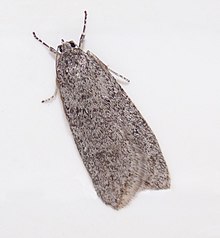
The scalloped oak is a moth of the family Geometridae. The species was first described by Carl Linnaeus in his 1758 10th edition of Systema Naturae.

The coxcomb prominent is a moth of the family Notodontidae. It is a common species throughout the Palearctic realm from Ireland to Japan. It was first described by Carl Linnaeus in his 1758 10th edition of Systema Naturae.

The nutmeg, also known as the clover cutworm, is a moth of the family Noctuidae.

The Hebrew character is a moth in the family Noctuidae. The species was first described by Carl Linnaeus in his 1758 10th edition of Systema Naturae. It is found throughout Europe.

The miller is a moth of the family Noctuidae. It is found throughout Europe apart from the far south-east. The range extends from the South of Spain, Central Italy and Bulgaria to Scotland and Central Scandinavia, crossing the Arctic Circle in Finland and Norway. Outside Europe it is only known in North Africa. In the Eastern Palearctic and the Nearctic realm it is replaced by Acronicta vulpina, formerly known as Acronicta leporina subspecies vulpina.
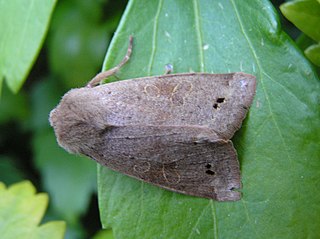
Perigrapha munda, the twin-spotted Quaker, is a species of moth of the family Noctuidae. The wings are gray, with two closely approximate and very conspicuous dark spots on the disc of the fore wings. a small dark apical mark at the costal edge and a discal spot on the fuscous hindwings. It is found in Palearctic realm.

Xanthia togata, the pink-barred sallow, is a species of moth of the family Noctuidae. It is a Holarctic species, and is found throughout Europe and east through the Palearctic to Central Asia, and Siberia up to the Ussuri. The distribution area includes the United States and Canada. It was first described by the German entomologist Eugenius Johann Christoph Esper in 1788 from the type specimen in Germany

Batrachedra praeangusta is a moth of the family Batrachedridae which is native to Europe. It is also found in North America. It was first described by Adrian Haworth in 1828 from the type specimen found in England. The foodplants of the larvae are poplars and willows.
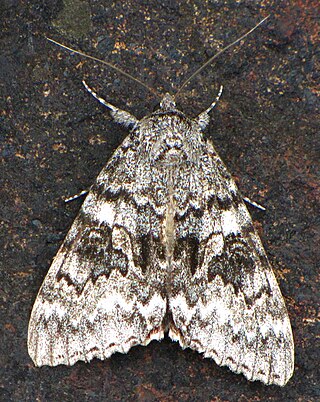
Catocala semirelicta, the semirelict underwing, is a moth of the family Erebidae. The species was first described by Augustus Radcliffe Grote in 1874. It is found in North America from Nevada, Colorado, Utah, California, and Nova Scotia south to Maine, west across Canada to British Columbia, and southward in the mountains.

Eulithis testata, the chevron, is a moth of the family Geometridae. The species was first described by Carl Linnaeus in 1761. It is found in both the Palearctic and the Nearctic realms. In the Palearctic it ranges from Great Britain and Scandinavia, south to the Alps, east through Russia and the Russian Far East to Japan. In North America, it is found from Newfoundland to Vancouver Island and Alaska, south in the east to about New Jersey and in the west to Colorado.

Epinotia nisella is a moth of the family Tortricidae which is found in the Palearctic, Europe and North America. It was first described by Carl Alexander Clerck in 1759.

Semioscopis is a moth genus of the superfamily Gelechioidea. It is placed in the subfamily Depressariinae.

Semioscopis avellanella is a species of moth of the family Depressariidae. It is found in most of Europe east to the eastern parts of the Palearctic realm.
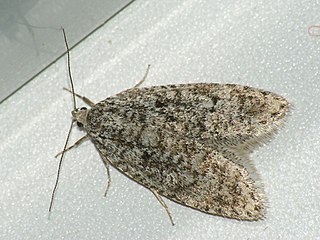
Semioscopis strigulana is a species of moth of the family Depressariidae. It is found in most of Europe east to the eastern parts of the Palearctic realm.
Semioscopis aurorella, the aurora flatbody moth, is a species of moth of the family Depressariidae. It was described by Harrison Gray Dyar Jr. in 1902. It is found in Canada from north-central Alberta to south-eastern Ontario, south into the United States between south-central New York and Wisconsin.

Semioscopis merriccella is a species of moth of the family Depressariidae. It was described by Harrison Gray Dyar Jr. in 1902. It is found throughout the northern United States and southern Canada from the east to the west coast.
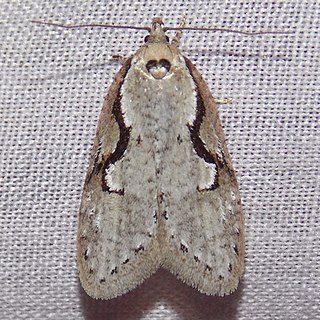
Semioscopis packardella, also called Packard's concealer moth or Packard's flatbody moth, is a species of moth of the family Depressariidae. It was described by James Brackenridge Clemens in 1863. It is found in North America in central Alberta, southern Quebec, Manitoba, California, Idaho and Oregon and from New Jersey to Ohio.
Ctenosia inornata is a moth of the subfamily Arctiinae. It was described by Alfred Ernest Wileman. It is found on Luzon in the Philippines.
Nites betulella, the black-dotted birch leaftier moth, is a moth in the family Depressariidae. It was described by August Busck in 1902. It is found in North America, where it has been recorded from Nova Scotia, southern Canada, the north-eastern United States, British Columbia and Wisconsin.
Galactica inornata is a moth in the family Galacticidae. It was first described by Walsingham in 1900. It is found in Yemen (Socotra).
